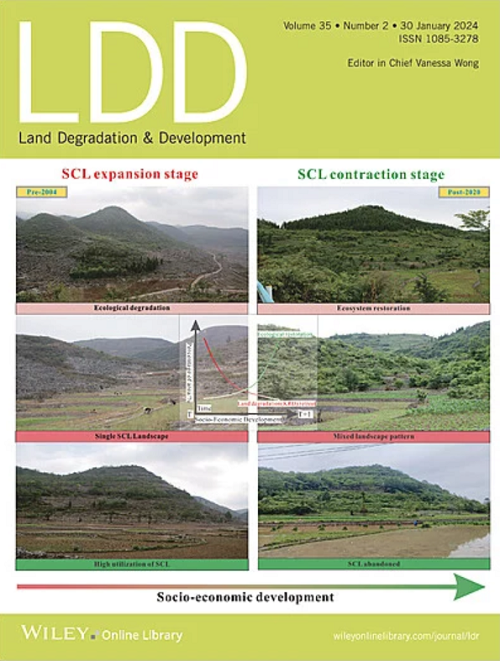Two Decades of Ecological Quality Evolution Along the Sichuan‐Tibet Highway: Improvement, Localized Degradation and Grazing Intensity Dominating Changes Post‐2010
IF 3.6
2区 农林科学
Q2 ENVIRONMENTAL SCIENCES
引用次数: 0
Abstract
The environmental quality and soil erosion dynamics of the eastern margin of the Tibetan Plateau are vital to regional sustainability, since it is an ecologically sensitive area. In this study, we combined the Remote Sensing Ecological Index (RSEI) and Modified Universal Soil Loss Equation (RUSLE) model to develop a Composite Ecological Quality Index (CEQI). This approach was used to examine the spatio‐temporal distribution patterns and driving factors of ecological quality and soil erosion in the transition zone from the Tibetan Plateau–Hengduan Mountains to Chengdu Plain, over the past 20 years (2000–2020). The CEQI results showed a 24% improvement in the study area's ecological quality, and a major east–west gradient difference was observed, with the eastern plains experiencing significant improvements as a result of China's Grain‐for‐Green Project. Moreover, the central and western high‐altitude areas experienced environmental degradation due to the impact of human activities, such as grazing intensity and changes in natural factors that caused the RSEI to decrease by 10%. This study also found a 2.61% increase in soil erosion modulus, with severe erosion concentrated in the Qamdo–Nagqu area where the interaction between climate change and topography was a key driver in the spatial differentiation. The optimal parameters‐based geographical detector (OPGD) and random forest model (RFM) further showed that precipitation, temperature, and land use dominated changes in environmental quality before 2010. The combined effects of grazing intensity, temperature, and precipitation explained the changes in ecological quality after 2010 with the government's implementation of environmental policies.川藏高速公路沿线20年生态质量演变:改良、局部退化和放牧强度主导变化
青藏高原东部边缘地区是生态敏感区,其环境质量和水土流失动态对区域可持续发展至关重要。本研究将遥感生态指数(RSEI)与改良通用土壤流失方程(RUSLE)模型相结合,建立了复合生态质量指数(CEQI)。利用该方法研究了青藏高原-横断山脉-成都平原过渡带近20年(2000-2020年)生态质量和土壤侵蚀的时空分布格局及其驱动因素。CEQI结果显示,研究区生态质量改善了24%,且呈现出明显的东西梯度差异,东部平原因中国退耕还林工程而得到显著改善。此外,由于人类活动的影响,例如放牧强度和自然因素的变化,导致中西部高海拔地区的RSEI下降了10%。研究还发现,土壤侵蚀模数增加了2.61%,严重侵蚀集中在昌多那曲地区,气候变化和地形的相互作用是空间分异的关键驱动因素。基于最优参数的地理探测器(OPGD)和随机森林模型(RFM)进一步表明,2010年以前,降水、温度和土地利用主导了环境质量的变化。放牧强度、温度和降水的综合效应解释了2010年后随着政府环境政策的实施,生态质量的变化。
本文章由计算机程序翻译,如有差异,请以英文原文为准。
求助全文
约1分钟内获得全文
求助全文
来源期刊

Land Degradation & Development
农林科学-环境科学
CiteScore
7.70
自引率
8.50%
发文量
379
审稿时长
5.5 months
期刊介绍:
Land Degradation & Development is an international journal which seeks to promote rational study of the recognition, monitoring, control and rehabilitation of degradation in terrestrial environments. The journal focuses on:
- what land degradation is;
- what causes land degradation;
- the impacts of land degradation
- the scale of land degradation;
- the history, current status or future trends of land degradation;
- avoidance, mitigation and control of land degradation;
- remedial actions to rehabilitate or restore degraded land;
- sustainable land management.
 求助内容:
求助内容: 应助结果提醒方式:
应助结果提醒方式:


